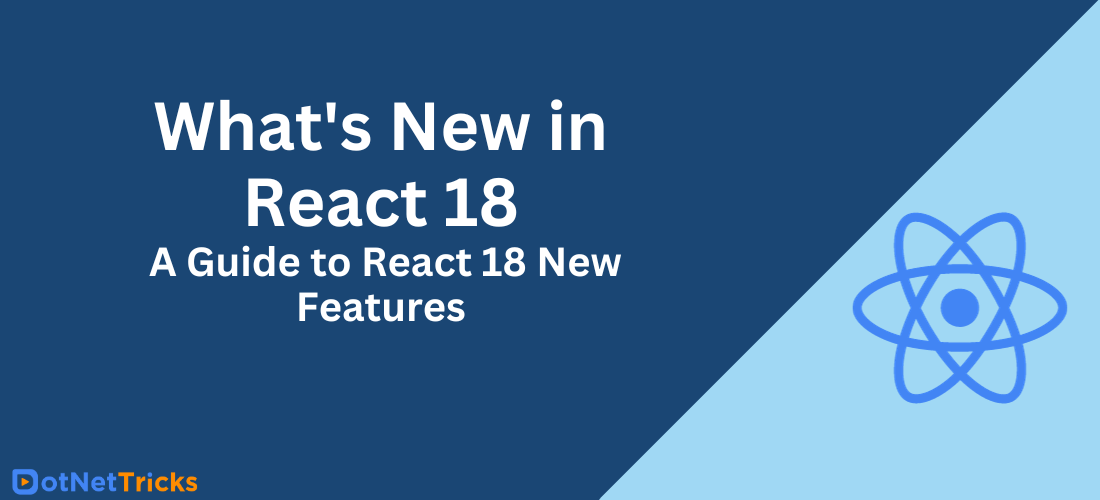28
apr.What's New in React 18: A Guide to React 18 New Features
What's New in React 18: An Overview
React 18 is currently the most discussed topic in the React tutorial and a trend in JavaScript. React v18.0, which offers highly anticipated continuous rendering improvements, has finally been released by the React team. Enroll in our React Certification Training to delve into React 18, exploring its new features and key modifications from React 17 for advanced expertise.
What is React 18
React 18 is a major upgrade to the popular web library that focuses on smoothness and performance. Because of the simultaneous react rendering that it introduces, your app will continue to function even when it is busy. Users benefit from quicker loading times and more effortless interactions as a result.
React 18 Concurrent Mode
- Concurrency is an innovative concept that React 18 introduced.
- It is a behind-the-scenes method that enables React to build several UI versions simultaneously, rather than a feature.
- This allows React to pause, restart, or even abort renderings without blocking the main thread, which fixes the long-standing problem of delayed UI updates.
- This makes the user experience more seamless, even when rendering complex scenes and makes features like reusable states possible for effective user interface transitions.
- Adopting concurrency opens up new possibilities for your React projects regarding responsiveness and flexibility, even though sticking with React 18 will keep your app.
React 18 New Features
- Rendering interruption: React 18 can pause, restart, and resume rendering operations, improving the responsiveness of your application even when rendering takes a long time. Because of this, users can engage with the user interface (UI) without interruption, even while computations or data fetching takes some time.
- Suspense on Server: You can display a loading state in react while you wait for data to arrive by using server-side rendered suspense components. Because the consumer views content gradually rather than waiting for everything to load at once, perceived performance is improved.
- Streaming Server Rendering: Rather than waiting for the full page to load, HTML portions can now be sent gradually through server rendering. Users can now interact with the rendered portions of the website and view material more quickly as a result.
- Automatic Batching: To increase efficiency and cut down on render cycles, React automatically groups several state updates. This improves the responsiveness and fluidity of your app, particularly when handling frequent state changes.
- Transitions: Updates can be ranked in order of urgency using the startTransition API. Non-urgent changes, such as background data retrieving, are batched and rendered later; urgent updates, such as user interactions, are handled instantly. This guarantees a seamless and quick user experience.
- useId and useDeferredValue hooks: The useId and useDeferredValue hooks in React simplify and improve the readability of your code by offering easy-to-use methods for managing deferred values and unique IDs across your React components.
What’s New in React 18?
- The new React 18 engine manages data fetching and updates expertly, maintaining your app's responsiveness and smoothness even under load.
- UseTransition ensures a smooth user experience by providing quick attention to urgent user interactions while delaying non-critical operations like data fetching.
- Pages served by servers now don't have to wait for everything. Users can view and engage with certain portions of the website more quickly as content is added piece by piece.
- Blank screens when retrieving data are no longer present. Now, suspense elements function on the server as well, displaying a welcoming loading status till everything is prepared.
- React 18 minimizes re-renders and maintains the speed of your application by intelligently grouping state updates.
- The useId and useDeferredValue hooks made managing IDs and deferred values easier. More clarity, less code, and content developers.
Library Side API changes
- useId
- useSyncExternalStore
- useInsertionEffect
Server Side API changes
- renderToPipableStream ( node env)
- renderToReadableStream ( edge env)
- renderToString is now deprecated.
Benefits of React 18 over React 17
- You could remain unsure about whether to use React 18 or React 17 after learning about their differences.
- A new edition won't be accepted if it doesn't provide more benefits than previous versions.
- Concurrency is one of React 18's main advantages. It is a whole new idea, not a feature, for React apps running on React 18 and higher to be able to perform better on client devices.
Summary
Concurrent rendering in React allows for more seamless performance, even with demanding jobs. Users enjoy smoother interactions and quicker loading times. Updates and data fetching are optimized by new features like Automatic Batching and Suspense on the Server. Transitions guarantee a responsive experience by giving priority to urgent user actions. React 18 upgrades provide new options for the responsiveness and flexibility of apps.
FAQs
Q1. What are new features added in React 18?
Q2. What is the difference between React 16 and React 18?
Q3. What are the concurrent features of React 18?
Q4. Why React 18 is better?
Q5. What are the new hooks in React 18?
Take our free skill tests to evaluate your skill!

In less than 5 minutes, with our skill test, you can identify your knowledge gaps and strengths.




